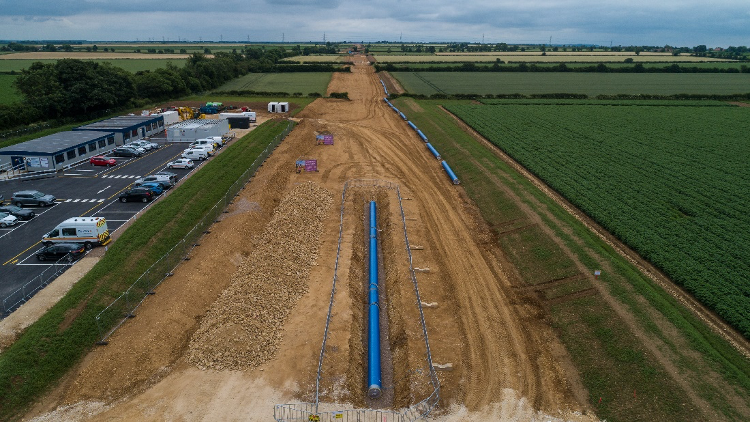What’s in the pipeline for resilience? A perspective from a young water industry professional
What’s in the pipeline for resilience? A perspective from a young water industry professional
Craig Hopkinson, Sustainability Manager for Anglian Water’s Strategic Pipeline Alliance (SPA), reflects on his role as a young person helping to deliver one of the largest infrastructure projects currently taking place in the United Kingdom.
This is the 10th story in the Windows on Resilience series produced by CDKN and the Resilience Knowledge Coalition for the COP26 Resilience Hub – a physical and virtual space at COP26 dedicated to sharing best practice and building collaboration, momentum and new opportunities on adaptation and resilience. This story series shares practical and inspiring resilience solutions from communities and countries around the globe. Register for the Resilience Hub here.
I started working for Anglian Water only three years ago. Anglian Water supplies water and manages wastewater for almost seven million people in the East of England. The day of my job interview was the same day that Sir James Bevan, Chief Executive of the UK’s Environment Agency, made a memorable speech referring to water shortages expected in England in the next 25 years, which he referred to as the ‘Jaws of death’. These shortages are expected as a combined result of climate change and population growth. Little did I know, when I first started working on the graduate programme at Anglian Water, that I would play a role in combatting this ‘existential threat’ to help protect the future of the country’s water supply.
Now I am the Sustainability Manager for the Strategic Pipeline Alliance (SPA), which is a dream job for someone as young as me. Until this position I struggled to connect with the climate crisis in relation to my local area of Lincoln, a town in the East of England, where it feels like the rain never stops! This was until I heard that some areas of this region, one of the driest in the country, experience lower annual rainfall than the water-scarce city of Jerusalem.
As one of the largest infrastructure projects currently taking place in the United Kingdom, SPA is delivering up to 500 kilometres of large interconnecting pipelines to move water from areas with surplus to areas that are in deficit. The project will increase climate resilience by providing an additional supply of water, supplementing that which has been lost due to the double hit of changing rainfall patterns and more customers using more water. This additional source will allow us to provide more water in areas that need it the most, helping to protect the natural water environment.
[caption id="attachment_107613" align="alignnone" width="625"] Aerial view of SPA pipelines[/caption]
Aerial view of SPA pipelines[/caption]
This programme forms a key part of Anglian Water’s Water Resources Management Plan (WRMP), which sets out how we’ll manage the water supplies in our region to meet both current and future needs over a period of 25 years. The new pipelines will also strengthen local resilience by introducing a new water source, reducing the number of homes and businesses relying on a single source.
It's not just a climate change adaptation story. SPA tackles both mitigation and adaptation, by embracing ambitious carbon reduction targets and enhancing water resilience. It focusses on four key areas:
Capital carbon refers to emissions associated with the creation of an asset. In this case, the vast majority of the emissions are embodied in the material from which the pipe is made. The project is on track to deliver an industry-leading reduction in capital carbon (a 65% reduction compared to a traditional solution). To reduce the length of new pipe needed, we’re optimising the existing water supply network and re-using existing pipes wherever possible. We are also incorporating renewable energy, to help us deliver on Anglian Water’s Net Zero 2030 roadmap.
One of our key approaches is digital transformation, in support of these goals. We’re creating an award-winning digital representation of the physical asset (a so-called ‘digital twin’). The digital twin enables us to refine the performance of the water infrastructure; for example, by supporting the design of more energy efficient solutions. Ultimately, these steps aim to minimise Anglian Water’s impact on the environment, while providing long-term water security to the East of England region.
One challenge faced on all major infrastructure projects is how to create a solution that meets both today and tomorrow’s needs. We’ve carried out advanced modelling to demonstrate that our new and existing pipes will be resilient to the expected changes in ground movement driven by hotter, drier summers and wetter, warmer winters. The results have given us confidence that our strategic pipeline will be fit for the future.
SPA really is in a race to resilience, delivering this ambitious programme by 2025. But to have a resilient future we need a resilient workforce, full of passion and hope. Without investing in the next generation, we’ll be setting ourselves up to fail. In my role, I’ve been lucky enough to bring in five young people through the government’s Kickstart Scheme who are new to the water industry. This project is a lot more than providing water resilience, it’s about leaving a legacy in the community we serve.
As a person who has a speech stammer, I was taught in therapy to create a toolkit of speech techniques to prepare for a variety of situations, from ordering a cup of coffee to delivering a presentation. The same logic can be applied for climate resilience: we need a wide range of solutions to best prepare for the uncertain future ahead. SPA may be just one element in Anglian Water’s resilience toolkit, but it will play a key part and I’m proud of the role I am playing.
To read more about SPA - https://www.anglianwater.co.uk/about-us/our-strategies-and-plans/new-water-pipelines/
To hear more about SPA - https://www.youtube.com/watch?v=wZv2qLKShqI
To talk more about SPA – https://www.linkedin.com/in/craig-hopkinson-57b23a114/
Photo: Craig on site for the SPA.

